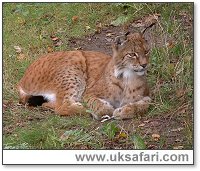
|

|
|
 Sent
to you Sent
to you
by e-mail
|
|
Simply
enter your details and hit the send button
more
info |
|


Click Here

Links
Advertise
Terms of Use
Contributors
About Us
Contact Us
|
 |
Go back
 | Bookmark
| Bookmark
 | Print Page
| Print Page  | E-Mail Us
| E-Mail Us 


 Photo: G. Bradley
Photo: G. Bradley
|
|
UK
Safari Tip:
There have been numerous sightings of lynx in the British countryside in recent
years, but these are most likely escaped / released individuals from private
collections.
|
|
Latin name: Felis lynx
Size: Head and body up to 130cms. Tail length approx 25cms.
Distribution: Extinct in the UK.
Food: Carnivore. Mainly deer, but will also take smaller prey such as
rabbits and hares.
Habitat: Forests, especially mountainous areas.
Special features: The lynx is a nocturnal, medium sized cat. The coat is
reddish-brown with dark brown spots. The tail is short with a black tip, and the
ears have long, black tufts of fur at the tips.
Lynx do not build dens. Instead the mothers place their cubs under a tree or close to rocks. A litter contains between one and four cubs. The young are independent at around 10 months and can live between 10 and 15 years.
The lynx became extinct in the UK by around the 10th century (possibly earlier).
This was probably the result of hunting and habitat loss.
Did You Know?
The International Union for the Conservation of Nature (IUCN) classified the lynx as the world’s most endangered cat.

UK Safari Mammal Section
|
 |

|